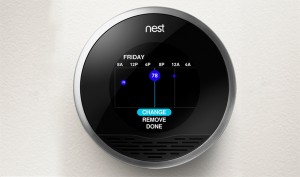- Tahoe’s Nevada Beach Tops the List of Hard-to-Book Campgrounds - 07/17/2024
- Cannabis Watershed Protection Program Cleans Up Illegal Grow Sites - 07/10/2024
- French Fire - 07/05/2024

Navigant Research reports that the number of smart thermostats in operation around the world will jump from 1.4 million currently installed to some 32 million by 2020. These kinds of numbers will help utilities meet or exceed energy efficiency goals regardless of other upgrades on their power plants. Photo: The Nest
Will I really be able to save money and energy in the long run by shelling out hundreds of dollars now for a so-called “smart” thermostat?
— Bill Cone, Aptos, CA
Spending $200 or more to replace that older, still functioning thermostat with a new whiz-bang “smart” variety might seem like a waste of money, but it can be one of the best small investments a homeowner can make, given the potential for energy and cost savings down the line.
The coolest of the bunch of new smart thermostats, the Nest, was created by former Apple employees who had been instrumental in designing the original iPod and iPhone years earlier. This simple looking round thermostat is reminiscent of old-school thermostats that one would manually adjust by turning the temperature dial. But the auto-awake feature that turns on the bright blue digital display when someone walks nearby gives the Nest away as an ultra-modern piece of high tech gadgetry.
The Nest’s software “learns” the habits in a given space by logging when inhabitants tend to be home and awake and noting when they tend to turn up or down the heat—and then sets a heating/cooling schedule accordingly. Owners can also program the Nest, which connects to the Internet via Wi-Fi, to heat up or cool down the house at a set schedule or go into “away” mode from any web browser or smart phone.
While the Nest is likely the best known smart thermostat available—especially since Google acquired the company behind it in early 2014—several other manufacturers (including Honeywell, ecobee, Hunter, Radio Thermostat, Trane and Lux) have Wi-Fi-enabled smart thermostats available now as well.
While only some of them have the auto-sensing and “learning” capabilities of the Nest, those without that feature also cost less. And merely programming in a weekly schedule to any smart thermostat will be the main source of cost and energy savings. People who were diligent about turning their old thermostats up and down throughout the day might not see any substantial savings with a smart thermostat, but most of us aren’t so diligent—especially when it comes to turning the heat down at night when we are sleeping.
Many smart thermostat owners report savings of between $10 and $30 per month on their heating/cooling bills—and research has shown that such an upgrade can save upwards of 10 percent of the total energy consumed by a given household. Smart thermostats range in price from $50 to $250, so upgrading could pay for itself within a year or two at most, with long-term savings racking up month-by-month after that.
Many utilities now offer free or discounted smart thermostats to customers. Getting in on such a program is a great way to reduce energy costs without the up-front expense of installing a smart thermostat independently. According to the Database of State Incentives for Renewables and Efficiency (DSIRE), incentives to install smart thermostats are available through utilities in 45 states. New York’s Con Edison, California’s PG&E and Texas’ CPS Energy are just a few of the larger utilities offering such incentives.
Those that do upgrade certainly won’t be alone. Navigant Research reports that the number of smart thermostats in operation around the world will jump from 1.4 million currently installed to some 32 million by 2020. These kinds of numbers will help utilities meet or exceed energy efficiency goals regardless of other upgrades on the power plant side of their businesses. Likewise, the efficiency boost also can play a key role in reducing our reliance on fossil fuels and our emissions of greenhouse gases.
CONTACTS: Nest, www.nest.com; DSIRE, www.dsireusa.org; Navigant, www.navigantresearch.com.
EarthTalk® is written and edited by Roddy Scheer and Doug Moss and is a registered trademark of E – The Environmental Magazine (www.emagazine.com). Send questions to: earthtalk@emagazine.com













